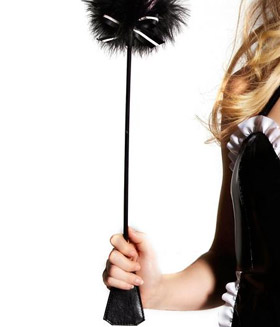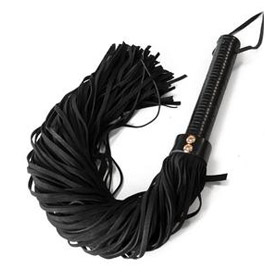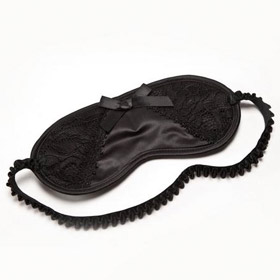The Ultimate Beginner's Guide to Bondage and BDSM

Curiosity may have killed the cat, but you can be sure that satisfaction brought it back. The previously dark and taboo world of BDSM has been thrust into the spotlight over the past few years, thanks to the never ending popularity of 'Fifty Shades of Grey', and we're firmly of the belief that the world can be a better place for it. A 2013 study even found that fans of bondage and S&M report better mental health!
If you're reading this guide to bondage, then we can safely assume that you're interested in bringing certain elements of this world into your sex life. Well you knocked on the door and Ann Summers has answered. We're here to help you on the road to all things kinky, so read our in-depth bondage guide to find out more. Welcome to the dark side, honey.

What is BDSM?
Before we can teach you how to do it, you first need to understand exactly what it is. Although people refer to BDSM as any kind of sexual play that isn't vanilla, it's actually an umbrella term that is made up of multiple different disciplines!
There are three main aspects of BDSM…
B&D - Bondage and Discipline. Bondage refers to the use of restraints in a manner that enhances sexual pleasure, whereas Discipline is the use of punishment or reward in response to a set of rules. So if you've ever spanked your partner for being naughty or used a pair of handcuffs, then congratulations! You have dabbled in the world of B&D.
D&S - Dominance and submission. This branch places a heavier emphasis on power play, hence why some refer to it as D/s (note the capital D and lower case s, which emphasises this further). This type of BDSM play can either be informal, such as a teacher and student fantasy, or much heavier in the form of humiliation. If you've ever acted out a power play fantasy, like boss and secretary, then you've dipped your toe in here.
S&M - Sadism and masochism. Remember the Rihanna song? Well this is what she was singing about! This branch is not only the most physical, but it's also the branch that you've likely come across most often thanks to popular culture. It often links in quite strongly with B&D and D/s aspects of play, or perhaps you're just into something a little rougher!
From hair pulling, spanking and biting, to paddling, whipping and clamps, it's all part of the S&M world.
Common myths about BDSM
'Fifty Shades of Grey' has lifted the curtain on the world of BDSM, but there are still a great deal of myths and misconceptions around it and the people who practice, and we're here to shed some light on the situation. This isn't a complete list by any means, but it goes some way to show that you should definitely do your research before believing everything you hear.
Myth #1 - Submissives in BDSM relationships are weak
Submissives, also known as subs or a "bottom", is the receiver of the action, so they are the ones who receive any physical punishment or are being controlled. On the surface, it seems as though the dominants are the strong ones and the submissives are bending to their will; it's actually somewhat the opposite!
The submissives actually have all the power; the dominant is only able to carry out those acts (which are from a pre-agreed list) because the submissive has consented to it. And, if the submissive should say 'no' at any point (more on this later), then the dominant has to stop. So you see, all the power is in the submissive's hands!
Myth #2 - BDSM always involves sex
This one is more of a generalisation and whilst, for many people, BDSM can be tied to sex (if you'll excuse the pun), many people firmly separate the two. Many professional Doms who are paid to carry out BDSM acts will not engage in sex with their submissives, as for some people it is a very separate act to sexual gratification. On the other hand, some couples may engage in sex during their BDSM scenes; it is simply a matter of personal preference!
Myth #3 - There's something wrong with you
Those who are completely new to bondage may assume that those who take part have undergone some kind of childhood trauma, or that they must have a mental condition in order to enjoy giving or receiving pain. Both could not be further from the truth. BDSM is simply a form of self-expression - and we certainly aren't ones to judge! It either floats your boat or it doesn't; all that matters is that you enjoy it!
Myth #4 - You're either a Dom or a Sub
There's a common misconception that you either fall into the category of a Dom or a Sub, usually based on your personality type. However, more often than not, the opposite can be true. Those who appear to be in control and dominating in their everyday life may prefer to submit and be told what to do behind closed doors, and vice versa.
But you don't need to segment yourself into one or the other. If you and your partner are just starting to explore this world, you can try out both roles, which is called being a "switch". Don't feel restricted; be free and let yourself explore.

Why engage in BDSM?
BDSM is a gateway to sexual experimentation, and can take your pleasure to whole new levels, but it also brings a whole number of other benefits to your general health and your relationship. The whole point of this bondage guide is to encourage you to be more open with your partner and experience new levels of pleasure.
So, let's take a look, shall we?
1. It enhances intimacy between couples
Any type of sexual expression requires a certain degree of intimacy, but during a BDSM scene that level of intimacy is actually greatly enhanced due to the physical risk that can actually be involved. Think about it; if you're going to be trussed up, gagged and blindfolded, or spanked, then you are placing an incredibly high level of trust in your partner.
And there's even some science to back this up, so don't just take our word for it! In 2009, a study was published in the Archives of Sexual Behavior that looked at the impact on couples bonding in consensual sadomasochistic activity, and found that when SM activities went well, there was an increase in relationship closeness.
2. It also helps your communication
Before two people can even think about taking part in a BDSM scene, they must communicate openly and honestly with one another. They must discuss their sexual desires and limits in great detail, come up with a "safe word" which immediately stops all play, and be able to draw the line between play and typical relationship behaviour.
Transparency and open and honest interaction are the founding pillars of a healthy BDSM relationship, and these can transfer into other areas of your life.

3. It can improve your mental health
Any kind of physical activity can have a positive effect on our mental health, whether it's exercise, physical touch or sex, thanks to the release of endorphins and Oxytocin (the 'love' hormone) in our brains. But the same can also be said about BDSM.
We've already covered one of the myths regarding the world of BDSM; that those who practice it must have something wrong with their mental health. However, it might even be said that the opposite is true!
A study conducted in 2013 and published in the Journal of Sexual Medicine showed that those who partook in BDSM had higher scores on certain indicators of mental health compared to those who had vanilla sex. According to the findings, those who considered themselves to be 'BDSM-friendly' were more open to new experiences, were less rejection-sensitive, less neurotic, and more extraverted.
The 2009 study quoted above also found that those who participated in BDSM had lower levels of cortisol (the stress hormone) afterwards. And we all know the negative impact that stress can have on our mental and physical health.
4. You can experience more pleasure
The old saying is true; there really is a fine line between pleasure and pain. For many people, the notion of being in pain, whether that's through a light spanking or the prick of a Wartenberg Pinwheel, can really heighten the feelings of pleasure when they finally do arrive.
However, the notion of enhanced pleasure can actually go much further. If you restrict your partner's senses, by tying them up, adding a blindfold or earplugs to reduce their hearing, then their other senses will experience a spike in sensitivity; most notably their skin or sense of touch. Plus, not being able to see, hear or touch your partner can really add some spice to the proceedings.

What are the different types of BDSM?
The world of BDSM isn't just black and white; in fact it is anything but! There are dozens of different ways to play out there for you to experiment with, so you're sure to find something that suits your tastes.
To help introduce you to this whole new world, we'll cover just a few of the types out there, but remember this list isn't complete. We're just easing you in slowly, darling. Consider it inspiration for any bondage ideas when the time comes to play.
Role play: No doubt this is a category that the majority of readers will be familiar with. Student and teacher or patient and doctor; they all fall under the same category of role play.
Restraining: Also known as bondage, this type of play refers to any method that is used to bind you or your partner during a scene. This can include handcuffs, blindfolds, clamps, spreader bars, ropes, wrist and ankle cuffs, and hog ties. For those who are more advanced, ceiling suspension equipment and the use of bondage furniture like a St. Andrew's Cross can also come into play.
Japanese Rope Bondage: As we've explained above, ropes fall under the category of restraining already, but Japanese Rope Bondage is an art form in itself. This practice, also known as Shibari or Kinbaku, uses intricate rope patterns on the willing submissive to create harnesses and restraints, and can twist you into all kinds of positions.
Impact play: In a nutshell, impact play does exactly what it says on the tin; it's all to do with any type of impact that may be inflicted on a person's body. This covers bare-handed spanking, flogging, caning, whipping, paddling, or spanking with a ruler. Wanna spank? We'll show you how.
Sensation play: This refers to any type of play where you are enhancing the sensations your partner will experience. Some of the most common techniques include wax play or involving ice; playing with food such as melted chocolate or whipped cream; using feathers, scarves or ticklers; using a Wartenberg Wheel or electro toys.

Getting started with BDSM
If you've made it this far in our guide to bondage, then no doubt you're itching to get started. Hold onto those handcuffs for now, because there's just a few things that we need to cover first. Don't worry, we promise it'll all be worth it.
Know your limits
Are you okay with handcuffs but feel a little tentative towards spanking? Do you really like the use of toys, but anal sex is a big no-no for you? Whatever your kinks, tastes and preferences are, this is the time to make them known to your partner. Contrary to popular belief, both the Dom and the Sub in your scenario need to lay out your soft and hard limits, but what are they?
Soft limit - This is something that the person is hesitant about. They may be open to try but may also have conditions such as specific circumstances or no-go areas; for example you may like spanking but only on your behind rather than the tops of your thighs.
Hard limit - These are a big no-no; they should not be done at any time. Violating a hard limit, regardless of whether the partner agrees with it, is a big betrayal of trust and is frowned upon within the kink community. Respect your partner's boundaries!

Choose a safeword
First things first, what is a safeword? In the BDSM world, a safeword is a code word or a signal to be used by either the sub or the Dom to signify that they want the scene to stop immediately. We know what you're thinking; why not just say "no" or "stop". Well, you may say these during your scene but not mean them - if your partner is teasing you to the point of orgasm, for example - but you won't necessarily mean them.
Red, amber or green - Some BDSM practitioners prefer to keep things simple by working with a traffic light system. Green means everything is fine and the scene can continue. Amber gives a warning that the submissive is reaching their limits, and red means stop the scene straight away. If the Dom is unsure, asking "what is your colour?" is a way of gauging the situation without breaking the mood.
Something completely random - If the traffic light idea doesn't appeal to you, as it often won't for many beginners, a safeword can take the form of any random word that you wouldn't normally say during sex. The crazier the better here because the idea is to break the mood and bring your limits immediately to your partner's attention. But make sure you have both agreed on the correct word beforehand.
Non-verbal signals - If you've stepped your kinkiness up a notch and incorporated the use of blindfolds and gags, then the safeword may not be a word at all. This could be ringing a small bell, dropping a ball or clicking the fingers to get the Dom's attention.
Fail to plan, plan to fail
Now comes the fun part of the planning, deciding what you're actually going to do. This can include everything from the toys you are going to use, the positions you are going to get into, or even the fantasy that you are going to act out.
If you're really new to bondage you may want to start out small, perhaps incorporating a little dirty talk or some light spanking into your normal sexual routine. If you want more, discuss that before your next scene. You don't have to dive in headfirst with top-to-toe latex! Unless you want to, of course.

Dipping your toe in: Getting started with bondage
Okay, now comes the fun part. Are you ready?
Dig out those fluffy handcuffs that you got in a Secret Santa years ago (you saved them for a reason) and test the waters that way with a bit of light bondage. Experiment with a bit of rough play the next time you climb between the sheets, perhaps with some hair pulling, or even take the plunge and try a bit of hand spanking. Or maybe use a tie or scarf to blindfold your partner? Incorporating these light elements into your normal sex play can really help to ease the transition from vanilla to something a little darker.
You don't have to invest in any toys or equipment just yet, but by dipping your toe into the waters you can start to get a feel of whether it's the right road for you.

Taking things to the next level…
Like what you've tasted so far? Then it may be time to step it up a notch. Why not invest in a few tools of the bondage trade to make sure you're fully equipped for the kinky challenge that lies ahead?
Give your hand a rest and try out a whip, cane or paddle instead. Remember it doesn't have to hurt; the lightest sensations can help to enhance the sensations far more than a hard whip.
Toe the line between pleasure and pain with some clamps, either nipple or clit. Adjustable ones are better for beginners, as they can produce a gentle sensation without taking things too far. Other tools to help you take things to the next level include spreader bars (leave your sub completely at your mercy), gags (stop that backchat in its tracks) or a collar and lead (if you're in a particularly controlling mood).

For the more advanced bondage players
Once you have experimented with bondage play for some time, and believe that you are ready to take the next step, there are more "advanced" areas that you can start to dabble in. The most hardcore stage is usually called 'edge play' because it does, quite literally, push the boundary edges of what you, or your partner, is able to withstand.
If you're looking to take the next step, electro play might be a good place to start. This involves the use of low-voltage electrical currents to stimulate the cells in your skin and body. Don't worry, they aren't strong enough to do any serious harm, and you'll more likely experience a tingle than a sharp shock. But we place it in our advanced section as many people will be immediately put off by the thought of electrical currents.
Humiliation play may be a hard limit for some, but many people actually enjoy the feelings that it can bring. This type of hard bondage play has a wide spectrum in itself, from being degraded with certain names in the privacy of your own bedroom (remember, it's important to agree on the insults beforehand) - you could start by talking dirty and see where you want to go from there - to full blown forced public humiliation.
Above all, it's important to remember that there is a whole wide world out there, and we've only just scratched the surface here!

The importance of BDSM aftercare
Okay, you're almost there. You've had the important conversations, picked your safeword, laid out the toys and set the scene, but there is one essential part of BDSM that you mustn't forget: the aftercare.
What is BDSM aftercare?
A BDSM scene of any type can be incredibly taxing, on both the body and the mind. Aftercare is simply the time taken afterwards for a couple to take care of one another's needs. More often than not, the Dom will look after their Sub; tending to their emotional and physical needs, but the Dom needs attention too. Aftercare is the part of a scene where both participants take time to 'get back to reality'.
Why do we need aftercare?
When two people take part in a scene, they are assuming roles that they don't play in real life. Whilst you may enjoy being tied to a bed and spanked behind closed doors, you certainly don't want your partner to mirror the often degrading aspects of a BDSM scene in your everyday relationship. Aftercare allows you to recalibrate in your relationship, and to get back to a sense of normality. It is essential that you allow the two parts of your lives to separate.
The reason why it is usually the Sub who requires a great deal of aftercare is due to something called the 'sub drop'. The physical exertion of your scene acts very much like it would had you undergone some kind of intense exercise; it releases a rush of endorphins and adrenaline that will suddenly peak and then drop as the scene comes to a close. This can leave the Sub feeling weak, dizzy, dazed, numb, shaky or even a little emotional - this is all completely normal. What's important is how you handle it.
What are the types of BDSM aftercare?
Much like the effect that a BDSM scene can have on a person, the aftercare also splits into physical and emotional aftercare.
Physical - If your partner has been gagged, blindfolded, or restrained in any way then you will immediately want to release them. If you find that they are marked in any way, perhaps from a pair of handcuffs or some redness due to spanking, then it's a good idea to have some arnica cream nearby to help alleviate any soreness or potential bruising.
Get them something to eat or drink to help with their blood sugar and hydration levels, and cover them with a blanket or get them a favourite comfy outfit if they are cold, or they may suddenly have the need to protect their modesty. They might wish for you to run a bath or a shower, which serves both a practical purpose of cleaning up (if necessary) and helping to relax them.
If you have agreed beforehand, you might want to hold your partner close to you, and kiss and hug them. Whilst this is something that will often occur after vanilla sex (who doesn't love a good cuddle?), the physical connection between two partners can help to rebalance hormones.
Emotional - Providing reassurances is an important part of a Dom's job; no matter what they have done to their partner, whether it's spanking or name calling, it's important that the Sub feels loved and safe.
A large part of emotional aftercare is discussing the scene that you have just undergone together. This includes any feelings that you had during (both good and bad) and whether there is anything they would like to change in the future. It's also important that you reassure them that what you have done isn't wrong; some people may feel like they are "dirty" even if you have only engaged in light spanking! This is normal, and it is your job to comfort one another.
Sign up to emails and get
15% OFF
your first order
Stay in the loop on all things Ann Summers:
Updates on new arrivals, inspiration, offers and events!
*Discount only available on full price products and 5% off discounted products
By inputting your information, you agree that we can use it in accordance with our Privacy Policy. You are able to unsubscribe from marketing at any time. By proceeding you agree to our Terms and Conditions.
You must be over 18 to join our mailing list.
By inputting your information, you agree that we can use it in accordance with our Privacy Policy. You are able to unsubscribe from marketing at any time. By proceeding you agree to our Terms and Conditions.
You must be over 18 to join our mailing list.
